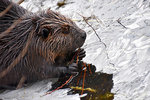 Narrowsburg
NarrowsburgLight Rain Fog/Mist, 43°
Wind: 8.1 mph
 Narrowsburg
NarrowsburgDid you know the beaver is New York State’s official mammal, or that it is North America’s largest rodent? I recently encountered the beaver depicted here and had the opportunity to …
Stay informed about your community and support local independent journalism.
Subscribe to The River Reporter today. click here
This item is available in full to subscribers.
Please log in to continue |


Did you know the beaver is New York State’s official mammal, or that it is North America’s largest rodent? I recently encountered the beaver depicted here and had the opportunity to observe it harvesting twigs from along an icy shoreline, then engaging in grooming activities.
Beaver are herbivores that use their large yellow incisors to eat the twigs, roots, bark and leaves of various aquatic plants. According to the New York State Department of Environmental Conservation, a beaver can chew down hundreds of trees in a year, and a family of beavers can consume up to a ton of bark during winter.
Their brown waterproof fur, webbed hind feet and ability to remain under water for up to 15 minutes allow them to adapt successfully to life in water. Beaver have a clear membrane that protects their eyes, valves that close off their ears and nostrils and lips that close behind their incisors to allow for carrying branches under water.
This intriguing mammal has been labeled “nature’s wetland engineer” for its successful construction of dams that result in the development of ponds. Eventually a new ecosystem emerges at the site, which benefits many wildlife species like amphibians, fish, reptiles and mammals such as muskrats and otters. Various species of waterfowl, ranging from wood ducks to great blue herons may gain access to nesting sites in dead snags or tree cavities and abundant sources of food. Water purification and storage are additional environmental benefits of the work of beaver.
Beaver also build lodges that can reach heights of more than 10 feet, consisting of large piles of branches covered with mud, plants and other debris. Access to the lodge is gained through underwater entrances and a loosely built opening is constructed at the top for ventilation.
At this time of year in the Upper Delaware River region, breeding is underway. Young will be born in May or June, with litter sizes ranging from two to seven kits, who will arrive fully furred with eyes open. Welcome to the neighborhood!
Comments
No comments on this item Please log in to comment by clicking here